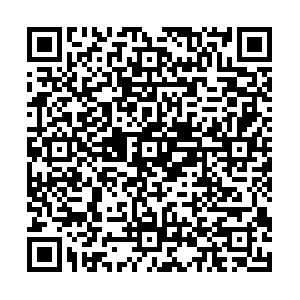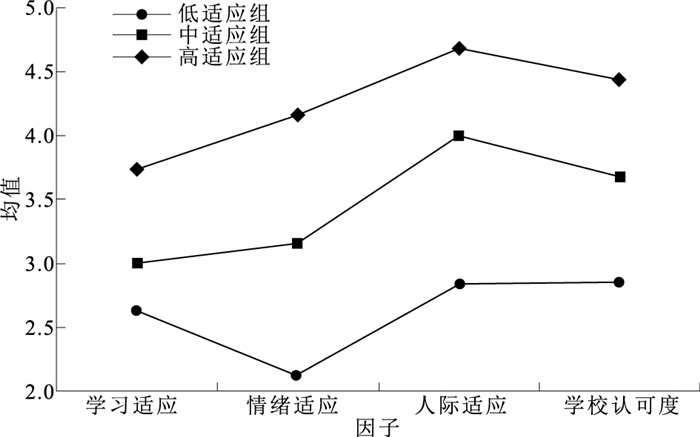Latent class of medical freshmen's school adjustment and the relationship among its transition, social support and mental resilience
-
摘要:
目的 探讨医学新生学校适应的潜在类别、类别转变特征及其与社会支持、心理韧性的关系,为开展教育干预提供科学依据。 方法 采用整群随机抽样法从福建省3所医学本科院校抽取1 155名医学新生为研究对象,2022年10月T1,采用学生适应性量表、青少年社会支持量表与心理韧性量表进行问卷调查,2022年12月T2,再次进行学生适应性量表的问卷调查,采用潜在剖面分析、潜在转变分析以及多元Logistic回归分析处理数据。 结果 T1和T2两个时间点上学校适应均存在3种亚类型,分别是高适应组(34.0%,19.8%)、中适应组(60.5%,53.8%)与低适应组(5.5%,26.4%)。低适应组的稳定性最强,保持原组的概率为94.0%;高适应组倾向于转变至中适应组,转变概率为25.0%;中适应组倾向于转变至低适应组,转变概率为22.0%。以类别不变组为参照,在社会支持作用下,高适应组更不可能转向中适应组(OR=0.40)和低适应组(OR=0.26),中适应组更可能转向高适应组(OR=1.47)、更不可能转向低适应组(OR=0.58);在心理韧性作用下,高适应组更不可能转向中适应组(OR=0.20)和低适应组(OR=0.13),中适应组更可能转向高适应组(OR=9.17)、更不可能转向低适应组(OR=0.42),低适应组更可能转向高适应组(OR=5.43)(P值均 < 0.05)。 结论 医学新生学校适应存在3个类别,类别转变呈现较高风险,社会支持与心理韧性在转变中起保护作用。应增强医学新生的社会支持和心理韧性水平,以促进学校适应。 Abstract:Objective To explore the possible latent classes and transition characteristics of medical freshmen and their relationship with social support and mental resilience, so as to provide a scientific reference for preventive education. Methods A total of 1 155 medical freshmen were cluster random sampled from 3 medical universities in Fujian Province and received 2 rounds of surveys(T1, October 2022; T2, December 2022) by applying Student Adaptation to College Questionnaire, Child and Adolescent Social Support Scale and Connor-Davidson Resilience Scale. And the relevant data was analyzed by using latent profile analysis, latent transition analysis and multiple Logistic regression. Results There were three different subgroups of school adjustment at two time points for T1 and T2, including high school adjustment group (34.0%, 19.8%), mild school adjustment group (60.5%, 53.8%) and low school adjustment group (5.5%, 26.4%). The low school adjustment group, relatively stable, had the greatest probability of remaining in the same group(94.0%). The high school adjustment group tended to change to mild school adjustment group(25.0%), and the mild school adjustment group tended to change to low school adjustment group (22.0%). Affected by social support, high school adjustment group was less likely to transfer to be mild school adjustment group (OR=0.40) and low school adjustment group (OR=0.26). The mild school adjustment group was prone to transfer to be high school adjustment group (OR=1.47), and less likely to be low school adjustment group (OR=0.58). Influenced by mental resilence, high school adjustment group was less likely to transfer to be mild school adjustment group (OR=0.20) and low school adjustment group (OR=0.13). The mild school adjustment group was prone to transfer to be high school adjustment group (OR=9.17), and less likely to be low school adjustment group (OR=0.42). The low school adjustment group was more likely to transfer to be high school adjustment group(OR=5.43)(P < 0.05). Conclusions There are three subgroups of school adjustment in medical freshmen, and class transition in school adjustment are at higher risk and are influenced by social support and mental resilience. The social support and resilience of medical freshmen should be enhanced to promote the school adjustment. -
Key words:
- Adaptation, psychological /
- Social support /
- Mental health /
- Regression analysis /
- Students
1) 利益冲突声明 所有作者声明无利益冲突。 -
表 1 大一新生学校适应与社会支持、心理韧性相关性分析(r值,n=1 155)
Table 1. The correlation analysis of school adjustment, social support and resilience in freshmen(r, n=1 155)
变量 T1学校适应 T2学校适应 社会支持 心理韧性 性别 独生子女 T2学校适应 0.67** 社会支持 0.48** 0.40** 心理韧性 0.50** 0.61** 0.39** 性别 -0.09* 0.01 0.11** -0.06 独生子女 0.01 -0.01 -0.08* -0.03 0.13** 家庭所在地 -0.01 -0.01 -0.12** -0.05 0.01 0.23** 注: *P<0.05,**P<0.01。 表 2 大一新生学校适应潜在剖面模型拟合指数(n=1 155)
Table 2. Fit index of latent profile model of school adjustment in freshmen(n=1 155)
时点 类别数 df AIC值 BIC值 aBIC值 Entropy值 PLMRT值 PBLRT值 类别概率/% T1 2 13 8 459.55 8 525.22 8 483.93 0.71 <0.01 <0.01 51.7/48.3 3 18 8 064.22 8 155.15 8 097.98 0.84 <0.01 <0.01 60.5/34.0/5.5 4 23 7 894.49 8 010.69 7 937.63 0.76 0.01 <0.01 47.5/26.2/24.0/2.3 5 28 7 812.37 7 953.82 7 864.88 0.80 0.18 <0.01 46.5/26.6/22.5/2.3/2.1 T2 2 13 8 344.90 8 410.58 8 369.28 0.79 <0.01 <0.01 61.3/38.7 3 18 7 799.71 7 890.64 7 833.47 0.84 <0.01 <0.01 53.8/26.4/19.8 4 23 7 631.20 7 747.40 7 674.34 0.89 0.03 <0.01 53.5/23.8/20.3/2.4 5 28 7 496.09 7 637.54 7 548.60 0.81 <0.01 <0.01 31.6/30.0/19.4/16.8/2.2 表 3 大一新生社会支持与心理韧性预测变量影响下学校适应转变概率的发生比[OR值(95%CI),n=1 155]
Table 3. The ratio of school adaptation transition under the influence of social support and psychological resilience[(OR95%CI), n=1 155]
影响因素 学校适应类别 T2高适应组 T2中适应组 T2低适应组 社会支持 T1高适应组 0.40(0.29~0.55)** 0.26(0.16~0.42)** T1中适应组 1.47(1.08~2.29)* 0.58(0.45~0.76)** T1低适应组 0.55(0.05~5.67) 2.22(0.77~6.43) 心理韧性 T1高适应组 0.20(0.14~0.30)** 0.13(0.07~0.24)** T1中适应组 9.17(5.26~15.98)** 0.42(0.30~0.57)** T1低适应组 5.43(1.69~33.51)* 1.80(0.73~4.45) 注: *P<0.05,**P<0.01。 -
[1] LADD G W, KOCHENDERFER B J, COLEMAN C C. Classroom peer acceptance, friendship, and victimization: distinct relational systems that contribute uniquely to children' s school adjustment?[J]. Child Dev, 1997, 68(6): 1181-1197. [2] 牛端, 屈琼斐, 张杰锋. 高校学术与学术支持服务对新生学校适应的影响[J]. 大学教育科学, 2016(2): 10-16. https://www.cnki.com.cn/Article/CJFDTOTAL-JXGJ201602003.htmNIU D, QU Q F, ZHANG J F. Effect of university' s academic and academic-support service on freshmen' school adaption[J]. Univ Educ Sci, 2016(2): 10-16. (in Chinese) https://www.cnki.com.cn/Article/CJFDTOTAL-JXGJ201602003.htm [3] 刘爱楼, 王瑞明. 大学生抑郁情绪特征的潜在类别分析[J]. 中国临床心理学杂志, 2022, 30(5): 1208-1212. https://www.cnki.com.cn/Article/CJFDTOTAL-ZLCY202205040.htmLIU A L, WANG R M. Latent profile analysis on the characteristics of college students' depression[J]. Chin J Clin Psychol, 2022, 30(5): 1208-1212. (in Chinese) https://www.cnki.com.cn/Article/CJFDTOTAL-ZLCY202205040.htm [4] 王亚, 卢宁, 陈启荣. 潜在剖面分析在探索新疆籍大学生文化适应方式中的应用[J]. 中国临床心理学杂志, 2019, 27(1): 129-133. https://www.cnki.com.cn/Article/CJFDTOTAL-ZLCY201901026.htmWANG Y, LU N, CHEN Q R. Application of latent profile analysis in exploring acculturation strategy in college students from Xinjiang[J]. Chin J Clin Psychol, 2019, 27(1): 129-133. (in Chinese) https://www.cnki.com.cn/Article/CJFDTOTAL-ZLCY201901026.htm [5] LI J B, WANG Y S, SUN Y, et al. Individual and interpersonal correlates of changes in college adaptation among Chinese freshmen: a longitudinal study[J]. Curr Psychol, 2021, 42: 3349-3361. [6] 程刚, 张大均, 肖友琴, 等. 大学新生主观社会地位与抑郁的变化轨迹: 一项多元潜变量增长模型分析[J]. 心理发展与教育, 2016, 32(6): 753-760. https://www.cnki.com.cn/Article/CJFDTOTAL-XLFZ201606014.htmCHENG G, ZHANG D J, XIAO Y Q, et al. The longitudinal effects of subjective social status on depression in Chinese college freshmen transition: a multivariate latent growth approach[J]. Psychol Dev Educ, 2016, 32(6): 753-760. (in Chinese) https://www.cnki.com.cn/Article/CJFDTOTAL-XLFZ201606014.htm [7] 黎志华, 谢玮玉, 尹霞云, 等. 大学生抑郁的发展轨迹: 基于潜变量混合增长模型的分析[J]. 中国临床心理学杂志, 2018, 26(4): 711-715. https://www.cnki.com.cn/Article/CJFDTOTAL-ZLCY201804018.htmLI Z H, XIE W Y, YIN X Y, et al. Developmental trajectory of depressive symptoms in college students: a latent growth mixture model[J]. Chin J Clin Psychol, 2018, 26(4): 711-715. (in Chinese) https://www.cnki.com.cn/Article/CJFDTOTAL-ZLCY201804018.htm [8] FRYER L K. Latent transitions to learning at university: a latent profile transition analysis of first-year Japanese students[J]. Higher Educ, 2017, 73(3): 519-537. doi: 10.1007/s10734-016-0094-9 [9] BRONFENBRENNER U. The ecology of human development: experiments by nature and design, cambrige, mass[M]. Cambridge, U.K. : Havard University Press, 1979. [10] COHEN S, WILLS T A. Stress, social support, and the buffering hypothesis[J]. Psychol Bull, 1985, 98(2): 310-357. doi: 10.1037/0033-2909.98.2.310 [11] PARK J Y, HONG O. Factors affecting adjustment of first-year nursing students to college life: a descriptive correlational study[J]. Nurs Educ Today, 2021, 102: 104911. doi: 10.1016/j.nedt.2021.104911 [12] LUTHAR S S, CICCHETTI D, BECKER B. The construct of resilience: a critical evaluation and guidelines for future work[J]. Child Dev, 2000, 71(3): 543-562. doi: 10.1111/1467-8624.00164 [13] HAKTANIR A, WATSON J C, ERMIS-DEMIRTAS H, et al. Resilience, academic self-concept, and college adjustment among first-year students[J]. J Coll Stud Retent Res Theory Pract, 2021, 23(1): 161-178. doi: 10.1177/1521025118810666 [14] 欧阳娟. 大学新生适应性量表(SACQ)的修订与应用研究[D]. 长沙: 湖南师范大学, 2012.OUYANG J. Revision and application of the Adaptability Questionnaire of Freshmen[D]. Changsha: Hunan Normal University, 2012. (in Chinese) [15] 罗雪峰, 陈启山, 沐守宽. 儿童及青少年社会支持量表的中文版修订及初步应用[J]. 中国临床心理学杂志, 2017, 25(4): 671-674. https://www.cnki.com.cn/Article/CJFDTOTAL-ZLCY201704018.htmLUO X F, CHEN Q S, MU S K. Child and Adolescent Social Support Scale: validation and preliminary application[J]. Chin J Clin Psychol, 2017, 25(4): 671-674. (in Chinese) https://www.cnki.com.cn/Article/CJFDTOTAL-ZLCY201704018.htm [16] 于肖楠, 张建新. 自我韧性量表与Connor-Davidson韧性量表的应用比较[J]. 心理科学, 2007(5): 1169-1171. doi: 10.3969/j.issn.1671-6981.2007.05.038YU X N, ZHANG J X. A comparison between the Chinese version of Ego-resiliency Scale and Connor-Davidson Resilience Scale[J]. Psychol Sci, 2007(5): 1169-1171. (in Chinese) doi: 10.3969/j.issn.1671-6981.2007.05.038 [17] 王孟成, 毕向阳. 潜变量建模与Mplus应用[M]. 重庆: 重庆大学出版社, 2018.WANG M C, BI X Y. Latent variable modeling and Mplus application[M]. Chongqing: Chongqing University Press, 2018. (in Chinese) [18] OSHRI A, DUPREY E B, KOGAN S M, et al. Growth patterns of future orientation among maltreated youth: a prospective examination of the emergence of resilience[J]. Dev Psychol, 2018, 54(8): 1456-1471. doi: 10.1037/dev0000528 [19] CREDE M, NIEHORSTER S. Adjustment to college as measured by the student adaptation to college questionnaire: a quantitative review of its structure and relationships with correlates and consequences[J]. Educ Psychol Rev, 2012, 24(1): 133-165. doi: 10.1007/s10648-011-9184-5 [20] 古丽巴哈尔·卡德尔, 阿斯木古丽·克力木, 努尔曼古丽. 维吾尔族医学生学校适应与家庭社会支持关系分析[J]. 中国学校卫生, 2011, 32(6): 717-719. https://www.cnki.com.cn/Article/CJFDTOTAL-XIWS201106039.htmGULIBAHAR K, ASMUGURI K, NURMANGULI. Analysis on the relationship between school adjustment and family social support of Uighur medical students[J]. Chin J Sch Health, 2011, 32(6): 717-719. (in Chinese) https://www.cnki.com.cn/Article/CJFDTOTAL-XIWS201106039.htm [21] 李秀婷, 杨梦莹, 杨绪霞, 等. 护理本科生社会适应与心理弹性、社会支持和应对方式的关系[J]. 中华行为医学与脑科学杂志, 2014, 23(8): 750-752. doi: 10.3760/cma.j.issn.1674-6554.2014.08.022LI X T, YANG M Y, YANG X X, et al. The relationship between social adaptation and the resilience, social support and coping style in undergraduate nursing students[J]. Chin J Behav Med Brain Sci, 2014, 23(8): 750-752. (in Chinese) doi: 10.3760/cma.j.issn.1674-6554.2014.08.022 [22] RUTTER M. Resilience in the face of adversity: protective factors and resistance to psychiatric disorder[J]. Br J Psychiatry, 1985, 147(6): 598-611. doi: 10.1192/bjp.147.6.598 -







 下载:
下载:


